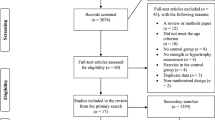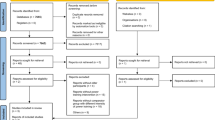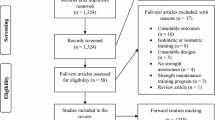Abstract
Background
Resistance training (RT) has been investigated as a potential intervention strategy for improving muscle function, but the effects on lower-extremity muscle power in middle-aged and older adults have not been systematically reviewed.
Objective
The aim of this meta-analysis is to provide a quantitative estimate of the effect of RT on lower-extremity muscle power in middle-aged and older adults and to examine independent moderators of this relationship.
Methods
Randomized controlled trials that examined the effects of RT on either leg press (LP) or knee extension (KE) muscle power in adults aged ≥50 years were included. Data were aggregated with meta-analytic techniques, and multi-level modeling was used to adjust for nesting effects. A total of 52 effects from 12 randomized controlled trials were analyzed with a random-effects model to estimate the effect of RT on lower-extremity muscle power. A multiple-regression analysis was conducted to examine independent moderators of the mean effect.
Results
The adjusted aggregated results from all studies indicate that RT has a small-to-moderate effect on lower-extremity muscle power (Hedges’ d = 0.34, 95 % confidence interval [CI] 0.25–0.43), which translated to 54.90 watts (95 % CI 40.37–69.43). Meta-regression analyses indicated that high-velocity RT was superior to traditional RT (Δ = 0.62 vs. 0.20, respectively) for increasing lower-extremity muscle power. In addition, training volume significantly moderated the effect of RT on muscle power.
Conclusion
The findings from this meta-analysis indicate that RT is an efficacious intervention strategy for improving LP and KE muscle power in adults aged ≥50 years. Training mode and volume independently moderate the effect of RT on lower-extremity muscle power, and should be considered when prescribing RT exercise for middle-aged and older adults.



Similar content being viewed by others
References
Administration on Aging. A profile of older Americans: 2013. Washington, DC: US Department of Health and Human Services; 2013.
Martin LG, Freedman VA, Schoeni RF, et al. Trends in disability and related chronic conditions among people ages fifty to sixty-four. Health Aff (Millwood). 2010;29:725–31.
Holmes J, Powell-Griner E, Lethbridge-Cejku M, et al. Aging differently: physical limitations among adults aged 50 years and over: United States, 2001–2007. NCHS Data Brief. 2009:1–8.
National Center for Health Statistics. Health, United States, 1996–97 and Injury chartbook. Hyattsville: US Department of Health and Human Services; 1997.
Fielding RA, Vellas B, Evans WJ, et al. Sarcopenia: an undiagnosed condition in older adults. Current consensus definition: prevalence, etiology, and consequences. International working group on sarcopenia. J Am Med Dir Assoc. 2011;12:249–56.
Cruz-Jentoft AJ, Baeyens JP, Bauer JM, et al. Sarcopenia: European consensus on definition and diagnosis: report of the European Working Group on Sarcopenia in Older People. Age Ageing. 2010;39:412–23.
Barbat-Artigas S, Rolland Y, Zamboni M, et al. How to assess functional status: a new muscle quality index. J Nutr Health Aging. 2012;16:67–77.
Metter EJ, Conwit R, Tobin J, et al. Age-associated loss of power and strength in the upper extremities in women and men. J Gerontol A Biol Sci Med Sci. 1997;52:B267–76.
Skelton DA, Greig CA, Davies JM, et al. Strength, power and related functional ability of healthy people aged 65–89 years. Age Ageing. 1994;23:371–7.
Clark DJ, Pojednic RM, Reid KF, et al. Longitudinal decline of neuromuscular activation and power in healthy older adults. J Gerontol A Biol Sci Med Sci. 2013;68:1419–25.
Knuttgen HG, Kraemer WJ. Terminology and measurement in exercise performance. J Strength Cond Res. 1987;1:1–10.
Foldvari M, Clark M, Laviolette LC, et al. Association of muscle power with functional status in community-dwelling elderly women. J Gerontol A Biol Sci Med Sci. 2000;55:M192–9.
Suzuki T, Bean JF, Fielding RA. Muscle power of the ankle flexors predicts functional performance in community-dwelling older women. J Am Geriatr Soc. 2001;49:1161–7.
Bean JF, Kiely DK, Herman S, et al. The relationship between leg power and physical performance in mobility-limited older people. J Am Geriatr Soc. 2002;50:461–7.
Cuoco A, Callahan DM, Sayers S, et al. Impact of muscle power and force on gait speed in disabled older men and women. J Gerontol A Biol Sci Med Sci. 2004;59:1200–6.
Rantanen T, Avela J. Leg extension power and walking speed in very old people living independently. J Gerontol A Biol Sci Med Sci. 1997;52:M225–31.
Bean JF, Leveille SG, Kiely DK, et al. A comparison of leg power and leg strength within the InCHIANTI study: which influences mobility more? J Gerontol A Biol Sci Med Sci. 2003;58:728–33.
Kuo HK, Leveille SG, Yen CJ, et al. Exploring how peak leg power and usual gait speed are linked to late-life disability: data from the National Health and Nutrition Examination Survey (NHANES), 1999–2002. Am J Phys Med Rehabil. 2006;85:650–8.
Skelton DA, Kennedy J, Rutherford OM. Explosive power and asymmetry in leg muscle function in frequent fallers and non-fallers aged over 65. Age Ageing. 2002;31:119–25.
Bassey EJ, Fiatarone MA, O’Neill EF, et al. Leg extensor power and functional performance in very old men and women. Clin Sci (Lond). 1992;82:321–7.
Ward-Ritacco CL, Adrian AL, Johnson MA, et al. Adiposity, physical activity, and muscle quality are independently related to physical function performance in middle-aged postmenopausal women. Menopause. 2014;21:1114–21.
Straight CR, Brady AO, Evans EM. Muscle quality and relative adiposity are the strongest predictors of lower-extremity physical function in older women. Maturitas. 2015;80:95–9.
Reid KF, Fielding RA. Skeletal muscle power: a critical determinant of physical functioning in older adults. Exerc Sport Sci Rev. 2012;40:4–12.
Verbrugge LM, Jette AM. The disablement process. Soc Sci Med. 1994;38:1–14.
Evans WJ, Campbell WW. Sarcopenia and age-related changes in body composition and functional capacity. J Nutr. 1993;123:465–8.
Nelson ME, Rejeski WJ, Blair SN, et al. Physical activity and public health in older adults: recommendation from the American College of Sports Medicine and the American Heart Association. Circulation. 2007;116:1094–105.
Garber CE, Blissmer B, Deschenes MR, et al. American College of Sports Medicine position stand. Quantity and quality of exercise for developing and maintaining cardiorespiratory, musculoskeletal, and neuromotor fitness in apparently healthy adults: guidance for prescribing exercise. Med Sci Sports Exerc. 2011;43:1334–59.
Kraemer WJ, Adams K, Cafarelli E, et al. American College of Sports Medicine position stand. Progression models in resistance training for healthy adults. Med Sci Sports Exerc. 2002;34:364–80.
American College of Sports Medicine. American College of Sports Medicine position stand. Progression models in resistance training for healthy adults. Med Sci Sports Exerc. 2009;41:687–708.
Peterson MD, Rhea MR, Sen A, et al. Resistance exercise for muscular strength in older adults: a meta-analysis. Ageing Res Rev. 2010;9:226–37.
Peterson MD, Sen A, Gordon PM. Influence of resistance exercise on lean body mass in aging adults: a meta-analysis. Med Sci Sports Exerc. 2011;43:249–58.
Hruda KV, Hicks AL, McCartney N. Training for muscle power in older adults: effects on functional abilities. Can J Appl Physiol. 2003;28:178–89.
Henwood TR, Riek S, Taaffe DR. Strength versus muscle power-specific resistance training in community-dwelling older adults. J Gerontol A Biol Sci Med Sci. 2008;63:83–91.
Skelton DA, Young A, Greig CA, et al. Effects of resistance training on strength, power, and selected functional abilities of women aged 75 and older. J Am Geriatr Soc. 1995;43:1081–7.
Marsh AP, Miller ME, Rejeski WJ, et al. Lower extremity muscle function after strength or power training in older adults. J Aging Phys Act. 2009;17:416–43.
Reid KF, Martin KI, Doros G, et al. Comparative effects of light or heavy resistance power training for improving lower extremity power and physical performance in mobility-limited older adults. J Gerontol A Biol Sci Med Sci. 2014;70:374–80.
Fielding RA, LeBrasseur NK, Cuoco A, et al. High-velocity resistance training increases skeletal muscle peak power in older women. J Am Geriatr Soc. 2002;50:655–62.
de Vos NJ, Singh NA, Ross DA, et al. Optimal load for increasing muscle power during explosive resistance training in older adults. J Gerontol A Biol Sci Med Sci. 2005;60:638–47.
Evans WJ. Exercise strategies should be designed to increase muscle power. J Gerontol A Biol Sci Med Sci. 2000;55:M309–10.
Moher D, Liberati A, Tetzlaff J, et al. Preferred reporting items for systematic reviews and meta-analyses: the PRISMA statement. PLoS Med. 2009;6:e1000097.
Delmonico MJ, Lofgren IE. Resistance training during weight loss in overweight and obese older adults: what are the benefits? Am J Lifestyle Med. 2010;4:309–13.
Straight CR, Brady AO, Evans EM. Muscle quality in older adults: what are the health implications? Am J Lifestyle Med. 2015;9:130–6.
Henwood TR, Taaffe DR. Improved physical performance in older adults undertaking a short-term programme of high-velocity resistance training. Gerontology. 2005;51:108–15.
Reid KF, Callahan DM, Carabello RJ, et al. Lower extremity power training in elderly subjects with mobility limitations: a randomized controlled trial. Aging Clin Exp Res. 2008;20:337–43.
Hedges L, Olkin I. Statistical methods for meta-analysis. New York: Academic Press; 1985.
Lipsey M, Wilson D. Practical meta-analysis. Thousand Oaks: Sage Publications; 2001.
Cochran WG. The combination of estimates from different experiments. Biometrics. 1954;10:101–29.
Higgins JP, Thompson SG, Deeks JJ, et al. Measuring inconstency in meta-analyses. BMJ. 2003;327:557–60.
Egger M, Smith GD, Schneider M, et al. Bias in meta-analysis detected by a simple, graphical test. BMJ. 1997;315:629–34.
Rosenberg MS. The file-drawer problem revisited: a general weighted method for calculating fail-safe numbers in meta-analysis. Evolution. 2005;59:464–8.
Muthén L, Muthén B. Mplus user’s guide. Los Angeles: Muthen & Muthen; 1998–2012.
Cheung M. A model for integrating fixed-, random-, and mixed-effects meta-analyses into structural equation modeling. Psychol Methods. 2008;13:182–202.
Hox J, editor. Multilevel analysis: techniques and applications. 2nd ed. New York; 2010.
Froot K. Consistent covariance matrix estimation with cross-sectional dependence and heteroskedasticity in financial data. J Financ Quant Anal. 1989;24:333–55.
White H. A heteroskedasticity-consistent covariance matrix estimator and a direct test for heteroskedasticity. Econometrica. 1980;48:817–38.
Williams R. A note on robust variance estimation for cluster-correlated data. Biometrics. 2000;56:645–6.
Holviala J, Kraemer WJ, Sillanpaa E, et al. Effects of strength, endurance and combined training on muscle strength, walking speed and dynamic balance in aging men. Eur J Appl Physiol. 2012;112:1335–47.
Liu-Ambrose T, Nagamatsu LS, Graf P, et al. Resistance training and executive functions: a 12-month randomized controlled trial. Arch Intern Med. 2010;170:170–8.
Lohne-Seiler H, Torstveit MK, Anderssen SA. Traditional versus functional strength training: effects on muscle strength and power in the elderly. J Aging Phys Act. 2013;21:51–70.
Ramsbottom R, Ambler A, Potter J, et al. The effect of 6 months training on leg power, balance, and functional mobility of independently living adults over 70 years old. J Aging Phys Act. 2004;12:497–510.
Sayers SP, Gibson K. A comparison of high-speed power training and traditional slow-speed resistance training in older men and women. J Strength Cond Res. 2010;24:3369–80.
Latham NK, Bennett DA, Stretton CM, et al. Systematic review of progressive resistance strength training in older adults. J Gerontol A Biol Sci Med Sci. 2004;59:48–61.
Steib S, Schoene D, Pfeifer K. Dose-response relationship of resistance training in older adults: a meta-analysis. Med Sci Sports Exerc. 2010;42:902–14.
Hazell T, Kenno K, Jakobi J. Functional benefit of power training for older adults. J Aging Phys Act. 2007;15:349–59.
Porter MM. Power training for older adults. Appl Physiol Nutr Metab. 2006;31:87–94.
McComas AJ. Skeletal muscle: form and function. Champaign: Human Kinetics; 1996.
Straight CR, Brady AO, Evans E. Sex-specific relationships of physical activity, body composition, and muscle quality with lower-extremity physical function in older men and women. Menopause. 2015;22:297–303.
Jadad AR, Moore RA, Carroll D, et al. Assessing the quality of reports of randomized clinical trials: is blinding necessary? Control Clin Trials. 1996;17:1–12.
Author information
Authors and Affiliations
Corresponding author
Ethics declarations
Funding
No sources of funding were used to assist in the preparation of this review.
Conflict of interest
Chad Straight, Jacob Lindheimer, Anne Brady, Rodney Dishman, and Ellen Evans declare that they have no conflicts of interest relevant to the content of this review.
Rights and permissions
About this article
Cite this article
Straight, C.R., Lindheimer, J.B., Brady, A.O. et al. Effects of Resistance Training on Lower-Extremity Muscle Power in Middle-Aged and Older Adults: A Systematic Review and Meta-Analysis of Randomized Controlled Trials. Sports Med 46, 353–364 (2016). https://doi.org/10.1007/s40279-015-0418-4
Published:
Issue Date:
DOI: https://doi.org/10.1007/s40279-015-0418-4




